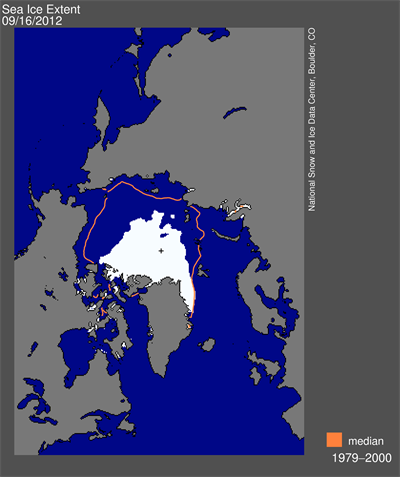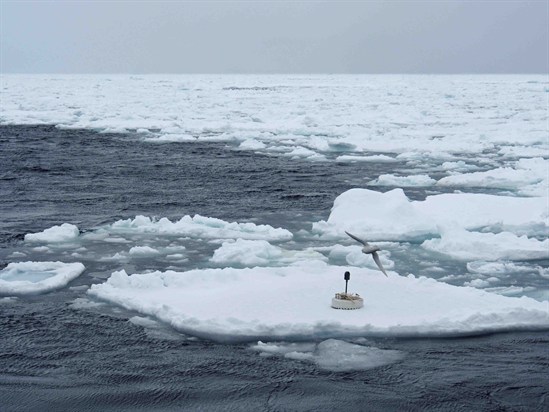Roz Pidcock
28.05.2014 | 6:00pmThe size of ocean waves could be the “missing science” behind why Antarctic sea ice is growing, say the authors of a new research paper. But as climate change bites, the destructive power of high winds and big waves could lead to sea ice retreat at both ends of the globe, the paper warns.
Over the course of a year, the amount of sea ice in both poles waxes and wanes with the seasons, reaching a low at the end of the summer. But there are also bigger changes afoot.
Since 1979, the Arctic has been losing sea ice at a rate of about four per cent per decade. At the opposite end of the earth, Antarctic sea ice is increasing by about 1.5 per cent per decade.
Scientists are confident climate change is driving Arctic sea ice loss. But it’s not clear what’s causing Antarctic sea ice to increase.
A new study, just published in the journal Nature, suggests an explanation. Changes in wave patterns could be closely linked to what’s happening at both poles, the study says.
Storms, waves and sea ice
Sea ice floats on top of the polar oceans. The area covered by ice grows in winter and melts or ‘retreats’ in summer as the amount of heat from the sun changes.
Scientists have long suspected waves generated by stormy weather can break up sea ice, causing it to retreat faster. A combination of high temperatures and stormy conditions is thought to be behind the record low amount of Arctic sea ice seen in September 2012.
Now, the authors of the new study say stormy weather is even more important to ice loss than previously thought, because of the power waves have to break up the ice.

Arctic sea ice reached a record low extent of 3.41 million square kilometers in September 2012.The orange line shows the average extent between 1979 and 2000. Source: NSIDC
Destructive power
For the new research, the team used sensors to measure wave height at five different locations in the Antarctic. Using another set of sensors, they measured the distance from the ice edge over which the waves carried enough energy to break up sea ice.
The scientists found large waves are much more destructive than previously thought – each wave carries enough energy to break up sea ice hundreds of kilometers from the ice edge. This suggests waves play a much more important role in breaking up sea ice than scientists realised.
The scientists also examined wave heights in the Southern Ocean around Antarctica between 1997 and 2009. They found increases and decreases in wave height in different regions closely matched the retreat and expansion of sea ice.
Lead author Dr Alison Kohout from the National Institute of Water and Atmospheric Research in New Zealand, tells us:
“[T]he key is the regional variability [in ice growth] (growing in some, retreating in others). Over the last 10 years or so, waves have been doing the same. Growing in some areas, reducing in others.”
For example, the paper explains the largest increases in wave height were found in the Amundsen-Bellinghausen Sea, where sea ice has retreated rapidly. Conversely, they found the smallest changes in the Western Ross Sea, where sea ice is known to have grown.
The close relationship came as a surprise to the team, Kohout explains:
“We expected some correlation, but perhaps not such a strong one”

A wave sensor on an ice floe shortly after deployment. Credit: Wendy Pyper
Bigger waves, bigger impact
Antarctic sea ice is growing overall, although there are big differences across the continent. If the scientists are right about the link between stormy weather and sea ice breakup, that might mean changes in stormy conditions have helped Antarctic ice grow.
If so, things won’t stay like this forever, say the authors.
As the climate warms, scientists expect waves to get stronger in the Arctic and Antarctic. That’s because the paths storms normally take in the atmosphere – called storm tracks – are expected move closer to the poles, bringing high winds in closer contact with the ice edge. The paper says:
“In the future, wave heights are predicted to increase everywhere at the sea ice edge in the Arctic and Antarctic. It is therefore conceivable that this will act to accelerate sea ice retreat.”
Most models currently overlook the impact of wave height across Antarctica, which is why they haven’t predicted the small increase in ice extent, the researchers say in the paper:
“Models have typically depended on measurements collected during the 1970s and early 1980s â?¦ Without improved knowledge of ice break up, we are unable to understand recent changes, or to predict future changes in Arctic and Antarctic sea ice.”
Predicting the behavior of sea ice – particularly the rate at which parts of the Arctic are becoming sea ice free in summer – has important consequences for climate, ecosystems, trade, geopolitics and resource extraction.
If ocean waves are more important in changes to polar sea ice than scientists previously thought, as this study suggests, this looks to be an area where models have a fair bit of room for improvement.
Kohout, A. L. et al., (2014) Storm-induced sea-ice breakup and the implictaions for ice extent. Nature doi:10.1038/nature13262

